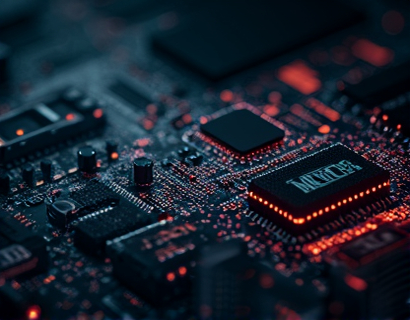DeFi Trading Amplified: Mastering Automated Market Makers for Optimal Automation and Liquidity
In the rapidly evolving world of decentralized finance, or DeFi, traders and enthusiasts are constantly seeking ways to enhance their trading experiences. One of the most transformative tools in this space is the Automated Market Maker, or AMM, particularly when leveraged through advanced smart-contract technology. This article delves into the intricacies of AMMs, exploring how they optimize liquidity management and automate trading strategies to ensure seamless and efficient market interactions. By understanding these concepts, crypto traders and DeFi enthusiasts can harness the full potential of decentralized trading, navigating the dynamic crypto landscape with confidence and precision.
Understanding Automated Market Makers
Automated Market Makers are decentralized protocols that facilitate trading without traditional order books. Instead of matching buy and sell orders, AMMs use mathematical formulas to determine the exchange rate between two assets. This approach eliminates the need for intermediaries, reducing transaction costs and increasing trading efficiency. The core mechanism of an AMM involves liquidity pools, where users deposit pairs of tokens to create a pool from which traders can borrow and lend. The smart contract governing the pool rebalances the token ratios based on predefined algorithms, ensuring liquidity and fair pricing.
One of the key advantages of AMMs is their ability to provide continuous trading without the slippage often associated with traditional order books. Slippage occurs when a large order causes the price to move against the trader, resulting in a less favorable execution price. AMMs mitigate this risk by using constant product formulas, such as x * y = k, where x and y are the amounts of the two tokens in the pool, and k is a constant. This ensures that the price remains stable even with large trades, providing a more predictable and controlled trading environment.
Optimizing Liquidity Management
Liquidity management is a critical aspect of DeFi trading, and AMMs offer sophisticated tools to enhance this process. By depositing tokens into liquidity pools, users become liquidity providers (LPs) who earn trading fees as a reward. These fees are automatically distributed based on the proportion of tokens each LP contributes to the pool. This incentivizes more users to participate, increasing the overall liquidity and making the market more efficient.
Advanced AMM protocols take liquidity optimization a step further by implementing dynamic fee structures and risk management tools. For instance, some platforms adjust fees based on market conditions, offering higher rewards during periods of low liquidity to attract more providers. Additionally, risk parameters can be set to limit exposure to extreme price movements, protecting LPs from potential losses. These features not only enhance user experience but also foster a more robust and resilient DeFi ecosystem.
Automating Trading Strategies
Automation is at the heart of AMMs, and when combined with smart-contract technology, it enables the execution of complex trading strategies with minimal human intervention. One of the most powerful features is the ability to set up automated trading bots that can execute trades based on predefined criteria. These bots can monitor multiple AMMs across different DeFi platforms, identifying arbitrage opportunities and executing trades to capitalize on price discrepancies.
Smart contracts can also be programmed to follow specific trading algorithms, such as mean reversion or momentum strategies. For example, a mean reversion bot might monitor the price deviation of a token from its historical average and automatically place buy or sell orders to profit from the token's return to its mean price. Similarly, momentum strategies can be automated to capitalize on trending assets by continuously adding to positions as the price moves in favor.
Another advanced feature is the integration of oracles, which provide real-time market data to smart contracts. Oracles ensure that trading bots have access to accurate and up-to-date information, enabling them to make informed decisions. This is particularly crucial in decentralized environments where data transparency and reliability are paramount.
Enhancing Market Interactions
The combination of optimized liquidity management and automated trading strategies significantly enhances market interactions in the DeFi space. Traders can execute trades more efficiently, with reduced slippage and lower costs. The continuous availability of trading pairs and the absence of intermediaries make AMMs an attractive option for both retail and institutional investors.
Moreover, the transparency of smart contracts builds trust among users, as all transactions and rules are publicly verifiable. This transparency is a cornerstone of the DeFi philosophy, promoting a more open and equitable financial system. By leveraging AMMs, users can participate in decentralized exchanges, yield farming, and other DeFi protocols with greater ease and confidence.
Challenges and Considerations
While AMMs offer numerous benefits, they also come with challenges that users should be aware of. One of the primary concerns is the impermanent loss, which occurs when the price of the tokens in a liquidity pool diverges from their original deposit prices. This can result in a permanent reduction in the value of the tokens held by LPs compared to holding them outside the pool. However, this risk can be mitigated by carefully selecting assets with stable price relationships and using AMMs with advanced risk management features.
Another consideration is the complexity of smart contracts. While they automate many processes, users need to understand the underlying mechanics to avoid potential pitfalls. It is essential to thoroughly research and test any AMM protocol before deploying capital. Additionally, the decentralized nature of these platforms means that users are responsible for their own security, including the safekeeping of private keys and awareness of potential scams.
Future Trends and Innovations
The future of AMMs is promising, with ongoing developments aimed at addressing current limitations and introducing new functionalities. One area of focus is the integration of more sophisticated oracles and data feeds to improve the accuracy of market data. This will further enhance the performance of automated trading bots and reduce the risk of mispricing.
Another exciting development is the emergence of cross-chain AMMs, which enable trading across different blockchain networks. This interoperability expands liquidity and access to a broader range of assets, fostering a more interconnected DeFi ecosystem. Additionally, the incorporation of governance tokens and community-driven decision-making is becoming more prevalent, allowing users to have a greater say in the evolution of AMM protocols.
As the DeFi landscape continues to mature, we can expect to see more innovative applications of AMMs, such as decentralized lending integrated with AMMs, and the creation of more complex financial instruments built on top of these protocols. These advancements will further solidify AMMs as a fundamental component of the decentralized finance ecosystem.
In conclusion, Automated Market Makers represent a significant leap forward in decentralized trading, offering optimized liquidity management and automated trading strategies that enhance the overall trading experience. By understanding and leveraging these tools, crypto traders and DeFi enthusiasts can navigate the dynamic crypto landscape with greater efficiency and confidence. As the technology continues to evolve, the potential for innovation and growth in the DeFi space remains vast, promising a future where decentralized finance is not just an alternative but the norm.











































